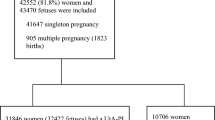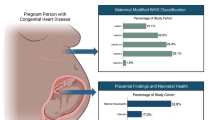Abstract
Objective:
To study the association between the cerebroplacental ratio (CPR) and the development of pre-eclampsia.
Study Design:
Three study groups were determined: Group 1—normal umbilical artery (UA; referent), Group 2—abnormal UA and normal CPR and Group 3—abnormal UA and an abnormal CPR. The primary outcome was the development of severe pre-eclampsia.
Results:
We included 270 women. Women in Group 3 had significantly elevated rates of severe pre-eclampsia versus those in Group 1 and Group 2, 52.5% versus 5.1% and 15.4%, respectively, (P<0.01), adjusted odds ratio 4.14 (95% confidence interval, 2.59 to 6.61). Kaplan–Meier analysis revealed earlier delivery in women with pre-eclampsia in Group 3 versus Group 1, Cox–Mantel hazard ratio 2.39 (1.17 to 4.88), log rank P=0.01.
Conclusion:
An abnormal CPR is associated with a higher rate severe pre-eclampsia with delivery at earlier gestational ages than with a normal UA or an abnormal UA, but normal CPR.
This is a preview of subscription content, access via your institution
Access options
Subscribe to this journal
Receive 12 print issues and online access
$259.00 per year
only $21.58 per issue
Buy this article
- Purchase on Springer Link
- Instant access to full article PDF
Prices may be subject to local taxes which are calculated during checkout



Similar content being viewed by others
References
American College of Obstetricians and Gynecologists. ACOG Practice Bulletin no. 134: fetal growth restriction. Obstet Gynecol 2013; 121 (5): 1122–1133.
Pilliod RA, Cheng YW, Snowden JM, Doss AE, Caughey AB . The risk of intrauterine fetal death in the small-for-gestational-age fetus. Am J Obstet Gynecol 2012; 207 (4)318 e1–e6.
Unterscheider J, O'Donoghue K, Daly S, Geary MP, Kennelly MM, McAuliffe FM et al. Fetal growth restriction and the risk of perinatal mortality-case studies from the multicenter PORTO study. BMC Pregnancy Childbirth 2014; 14 (1): 63.
Baschat AA, Cosmi E, Bilardo CM, Wolf H, Berg C, Rigano S et al. Predictors of neonatal outcome in early-onset placental dysfunction. Obstet Gynecol 2007; 109 (2 Pt 1): 253–261.
Rasmussen S, Irgens LM . History of fetal growth restriction is more strongly associated with severe rather than milder pregnancy-induced hypertension. Hypertension 2008; 51 (4): 1231–1238.
Odegård RA, Vatten LJ, Nilsen ST, Salvesen KA, Austgulen R . Preeclampsia and fetal growth. Obstet Gynecol 2000; 96 (6): 950–955.
Warrington JP, George EM, Palei AC, Spradley FT, Granger JP . Recent advances in the understanding of the pathophysiology of preeclampsia. Hypertension 2013; 62 (4): 666–673.
American College of Obstetricians and Gynecologists; Task Force on Hypertension in Pregnancy. Hypertension in pregnancy. Report of the American College of Obstetricians and Gynecologists’ Task Force on Hypertension in Pregnancy. Obstet Gynecol 2013; 122 (5): 1122–1131.
Lees C, Marlow N, Arabin B, Bilardo CM, Brezinka C, Derks JB et al. Perinatal morbidity and mortality in early-onset fetal growth restriction: cohort outcomes of the trial of randomized umbilical and fetal flow in Europe (TRUFFLE). Ultrasound Obstet Gynecol 2013; 42 (4): 400–408.
Alfirevic Z, Neilson JP . Doppler ultrasonography in high-risk pregnancies: systematic review with meta-analysis. Am J Obstet Gynecol 1995; 172 (5): 1379–1387.
Baschat AA, Gembruch U, Harman CR . The sequence of changes in Doppler and biophysical parameters as severe fetal growth restriction worsens. Ultrasound Obstet Gynecol 2001; 18 (6): 571–577.
Society for Maternal-Fetal Medicine Publications Committee Society for Maternal-Fetal Medicine Publications Committee, Berkley E Society for Maternal-Fetal Medicine Publications Committee, Chauhan SP Society for Maternal-Fetal Medicine Publications Committee, Abuhamad A . Doppler assessment of the fetus with intrauterine growth restriction. Am J Obstet Gynecol 2012; 206 (4): 300–308.
Baschat AA . Arterial and venous Doppler in the diagnosis and management of early onset fetal growth restriction. Early Hum Dev 2005; 81 (11): 877–887.
Mari G, Hanif F, Drennan K, Kruger M . Staging of intrauterine growth-restricted fetuses. J Ultrasound Med 2007; 26 (11): 1469–1477.
Mari G, Hanif F . Fetal Doppler: umbilical artery, middle cerebral artery, and venous system. Semin Perinatol 2008; 32 (4): 253–257.
Miller J, Turan S, Baschat AA . Fetal growth restriction. Semin Perinatol 2008; 32 (4): 274–280.
Unterscheider J, Daly S, Geary MP, Kennelly MM, McAuliffe FM, O'Donoghue K et al. Predictable progressive Doppler deterioration in IUGR: does it really exist? Am J Obstet Gynecol 2013; 209 (6): 539.
Mari G, Hanif F, Kruger M . Sequence of cardiovascular changes in IUGR in pregnancies with and without preeclampsia. Prenat Diagn 2008; 28 (5): 377–383.
Acharya G, Wilsgaard T, Berntsen GK, Maltau JM, Kiserud T . Reference ranges for serial measurements of umbilical artery Doppler indices in the second half of pregnancy. Am J Obstet Gynecol 2005; 192: 937–944.
Odibo AO, Riddick C, Pare E, Stamilio DM, Macones GA . Cerebroplacental Doppler ratio and adverse perinatal outcomes in intrauterine growth restriction: evaluating the impact of using gestational age-specific reference values. J Ultrasound Med 2005; 24 (9): 1223–1228.
Baschat AA, Gembruch U . The cerebroplacental Doppler ratio revisited. Ultrasound Obstet Gynecol 2003; 21 (2): 124–127.
Bahado-Singh RO, Kovanci E, Jeffres A, Oz U, Deren O, Copel J et al. The Doppler cerebroplacental ratio and perinatal outcome in intrauterine growth restriction. Am J Obstet Gynecol. 1999; 180 (3 Pt 1): 750–756.
Baschat AA . Fetal growth restriction - from observation to intervention. J Perinat Med 2010; 38 (3): 239–246.
Kutschera J, Tomaselli J, Urlesberger B, Maurer U, Häusler M, Gradnitzer E et al. Absent or reversed end-diastolic flow in the umbilical artery and abnormal Doppler cerebroplacental ratio—cognitive, neurological and somatic development at 3 to 6 years. Early Hum Dev 2002; 69 (1-2): 47–56.
Hershkovitz R, Kingdom JC, Geary M, Rodeck CH . Fetal cerebral blood flow redistribution in late gestation: identification of compromise in small fetuses with normal umbilical artery Doppler. Ultrasound Obstet Gynecol 2000; 15 (3): 209–212.
Murata S, Nakata M, Sumie M, Sugino N . The Doppler cerebroplacental ratio predicts non-reassuring fetal status in intrauterine growth restricted fetuses at term. J Obstet Gynaecol Res 2011; 37 (10): 1433–1437.
Hadlock FP, Harrist RB, Sharman RS, Deter RL, Park SK . Estimation of fetal weight with the use of head, body, and femur measurements—a prospective study. Am J Obstet Gynecol 1985; 151 (3): 333–337.
Harris P, Taylor R, Thielke R, Payne J, Gonzalez N, Conde J. et al. Research electronic data capture (REDCap): a metadata-driven methodology and workflow process for providing translational Research informatics support. J Biomed Inform 2009; 42: 377–381.
Acknowledgements
Study data were collected and managed with REDCap software (Research Electronic Data Capture), which is hosted at Cincinnati Children’s Hospital Medical Center under the Center for Clinical and Translational Science and Training grant support (UL1-RR026314-01 NCRR/NIH). REDCap is a secure, web-based application that was designed to support data capture for research studies to provide (1) an intuitive interface for validated data entry, (2) audit trails for tracking data manipulation and export procedures, (3) automated export procedures for seamless data downloads to common statistical packages and (4) procedures for importing data from external sources.28 This study was reviewed and approved by the University of Cincinnati Institutional Review Board, Protocol #12-07-05-03EE, approved 8/1/2013. This study received no external or internal funding support.
Author Contributions
The study was originally designed by Carri R Warshak. All authors, Carri R. Warshak, Jodi Regan and Heather Masters contributed to the IRB approval process, the data collection, statistical analysis and manuscript production.
Author information
Authors and Affiliations
Corresponding author
Ethics declarations
Competing interests
The authors declare no conflict of interest.
Additional information
This work was presented at the Society for Maternal Fetal Medicine annual meeting in February, 2014 in New Orleans, LA, USA. February 3rd to 8th 2014 (Program ID 314). This work has not previously been submitted for publication.
Rights and permissions
About this article
Cite this article
Regan, J., Masters, H. & Warshak, C. Association between an abnormal cerebroplacental ratio and the development of severe pre-eclampsia. J Perinatol 35, 322–327 (2015). https://doi.org/10.1038/jp.2014.210
Received:
Revised:
Accepted:
Published:
Issue Date:
DOI: https://doi.org/10.1038/jp.2014.210



